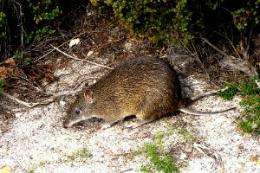The species was thought to be extinct until the discovery of a wild population of around 40 at Two Peoples Bay Nature Reserve near Albany in 1994. Flickr: mitogala
A recent translocation of 12 Gilbert’s potoroos (Potorous gilbertii) is helping save a species once thought to be extinct and revealing some surprise findings.
The Gilbert’s potoroo is a critically endangered Australian native animal and is the world’s rarest marsupial—existing only in pockets of WA’s south coast.
Department of Environment and Conservation (DEC) principal research scientist Dr Tony Friend says tracking the freshly transferred potoroos with radio transmitters is already yielding some surprising results about their behaviour.
“They do tend to move around in the first week of translocation usually, so it is early, but they seem to be moving as a group,” Dr Friend says.
“This challenges existing understandings, because often a lone male would just stick around a female, but this group is almost displaying herd behaviour.”
Dr Friend also says the Gilbert’s potoroos are venturing into a number of vegetation types they have never been exposed to before, such as jarrah woodland.
“This data gives us more information to select other potential translocation sites,” he says.
“The species is mostly fungivorous and the south coast of WA provides enough rain in summer to get good truffle abundance all year round.”
The species was thought to be extinct until the discovery of a wild population of around 40 at Two Peoples Bay Nature Reserve near Albany in 1994.
In the mid-2000s the DEC transferred 10 potoroos from Two Peoples Bay Nature Reserve to a predator-free environment on Bald Island as insurance against a loss of the mainland population. Since then, several more translocations have been successfully established.
The 12 most recently translocated Gilbert’s potoroos are joining another 9 released last year in an enclosure in Waychinicup National Park, 25km east of Albany.
If not for these efforts, it is possible this species would be lost forever.
“The question is not why there are so few; but why are the still around?” Dr Friend says.
The Gilbert’s potoroo is susceptible to predators such as cats, foxes, carpet snakes and even masked owls, but climate change is their major threat.
The situation could in fact be much worse if not for conservation efforts supported by HRH Prince Philip in the late 1960s.
As a keen bird-watcher, the Duke of Duke of Edinburgh fought against urbanisation and town planning along the Two People’s Bay coastline to save the newly rediscovered noisy-scrub bird (Atrichornis clamosus).
Unwittingly, these efforts would have also saved numbers of Gilbert’s potoroo.
Dr Friend says the next step is studying the species to learn further potential habitat relocation sites to ensure their survival.
Provided by ScienceNetwork Western Australia























